 Weird Stuff
Weird Stuff  Weird Stuff
Weird Stuff  Health
Health Ten Confounding New Inventions from the World of Biomedicine
 Creepy
Creepy 10 Death Superstitions That Will Give You the Creeps
 Movies and TV
Movies and TV 10 Movies That Get Elite Jobs Right, According to Experts
 Weird Stuff
Weird Stuff 10 Times Real Laws Were Based on Bizarre Hypotheticals
 Animals
Animals 10 Inspiring Tales of Horses Being Human
 Mysteries
Mysteries Top 10 Haunting Facts About the Ghost Ship MV Alta
 History
History 10 Surprising Stories About the Texas Rangers
 Humans
Humans 10 Philosophers Who Were Driven Mad by Their Own Theories
 Miscellaneous
Miscellaneous 10 Video-Game-Worthy Weapons and Armors from History
 Weird Stuff
Weird Stuff 10 Warning Labels That Exist Because Someone Actually Tried It
 Health
Health Ten Confounding New Inventions from the World of Biomedicine
 Creepy
Creepy 10 Death Superstitions That Will Give You the Creeps
Who's Behind Listverse?

Jamie Frater
Head Editor
Jamie founded Listverse due to an insatiable desire to share fascinating, obscure, and bizarre facts. He has been a guest speaker on numerous national radio and television stations and is a five time published author.
More About Us Movies and TV
Movies and TV 10 Movies That Get Elite Jobs Right, According to Experts
 Weird Stuff
Weird Stuff 10 Times Real Laws Were Based on Bizarre Hypotheticals
 Animals
Animals 10 Inspiring Tales of Horses Being Human
 Mysteries
Mysteries Top 10 Haunting Facts About the Ghost Ship MV Alta
 History
History 10 Surprising Stories About the Texas Rangers
 Humans
Humans 10 Philosophers Who Were Driven Mad by Their Own Theories
 Miscellaneous
Miscellaneous 10 Video-Game-Worthy Weapons and Armors from History
10 Wild And Shocking Tales Of Baboons
Baboons never get as much attention as their cuter cousins. That’s probably thanks to their terrifying teeth, aggressive behavior, and less-than-photogenic faces. And that’s a shame. Baboons are really fascinating creatures, as long as you keep your distance, and history is full of weird stories about their wild behavior.
10Monkeys That Speak French
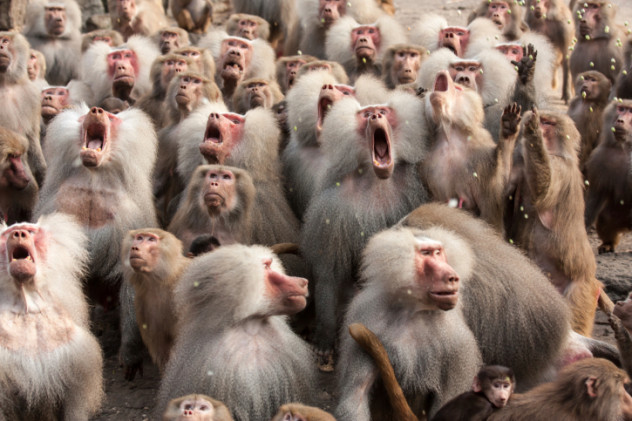
The zookeepers at the Port Lympne Reserve in Kent, England were having a bit of trouble. They’d recently received 19 Guinea baboons from the Paris Zoo, but these particular monkeys seemed rather confused. Anytime the keepers tried calling them for lunch, or giving any sort of command, the baboons just looked puzzled.
That’s when the keepers remembered the monkeys were from France. Any linguist—or child over the age of five—knows that French zookeepers generally speak French. As such, the baboons were used to hearing commands that sounded a little more romantic. Of course, the baboons didn’t actually understand French, but they’d come to associate certain sounds with certain results. When you hear dejeuner, that means the humans are bringing out the food.
So basically, the zookeepers had two choices: teach the monkeys English or brush up on their French. Since training the baboons to “understand” English would probably take months, the keepers decided to go with the second option. That’s why if you ever visit the Port Lympne Reserve, you might just hear a couple of British zookeepers shouting bonjour at a bunch of baboons.
9The Baboons Who Chose Peace
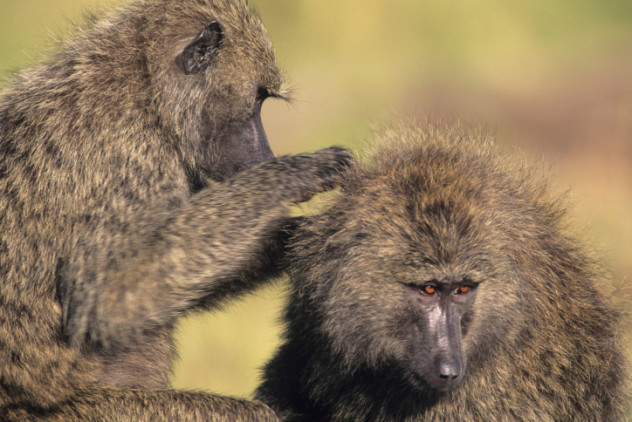
Baboons aren’t exactly the most peaceful monkeys on the planet. With their bad attitudes and razor-sharp canines, they’re some of the most aggressive animals you’ll ever encounter. According to Robert Sapolsky, a baboon troop is “the textbook example of a highly aggressive, male dominated, hierarchical society,” and they’re constantly duking it out with each other.
So who’s Robert Sapolsky? Well, he’s a Stanford neuroscientist who knows quite a bit about our furry, fanged friends. Sapolsky is an expert on stress and spends a lot of time studying baboons in the Serengeti. Thanks to their wild ways, baboon life is full of examples that demonstrate how stress takes a toll on society. After all, the males are fighting each other all the time. However, several years ago, something happened to a particular baboon troop that changed the way Sapolsky sees the African animals.
In the 1980s, Sapolsky was following a particular troop when he made an amazing discovery. They’d found a landfill behind a Kenyan tourist lodge, and it was full of all kinds of goodies including sandwiches, fries, and fruit. However, after a few months of free food, the baboons became infected with bovine tuberculosis. The disease ate away at the monkeys’ hands, forcing them to walk on their elbows, and soon almost all the males in Sapolsky’s troop were dead.
That’s when the neuroscientist noticed some strange behavior. Without all the males around, the females started behaving differently. Whenever a new male would wander into the troop, the ladies would start grooming him about six days after his arrival. Usually, when a new male shows up, all the females give him the cold shoulder for awhile. Why? Well, the new guy is on the bottom of the totem pole. The males constantly beat him up, and if they catch one of the girls grooming the new guy, they’ll turn on the females.
Normally, it takes three months before the ladies are allowed to clean his coat, but in Sapolsky’s troop, without the old alpha males around, the girls didn’t have to worry about repercussions and started grooming new males much sooner. This behavior had a strange calming effect on new members. Basically, whenever a new male showed up, he was groomed, and then he got along perfectly with the other males.
Even crazier, all the males started grooming each other. According to Sapolsky, that’s incredibly rare. Male baboons are generally too macho to pick fleas and ticks off another male’s coat, but in this troop, everybody was suddenly friends.
What’s really amazing is that over 20 years and multiple new males later, Sapolsky’s troop is still living a peaceful existence. They’ve essentially groomed aggressiveness out of their own society. And this has given Sapolsky hope, not just for baboons, but also for humanity. If monkeys can overcome their own violent nature, perhaps someday humans can too.
8Robinson The Stranded Baboon
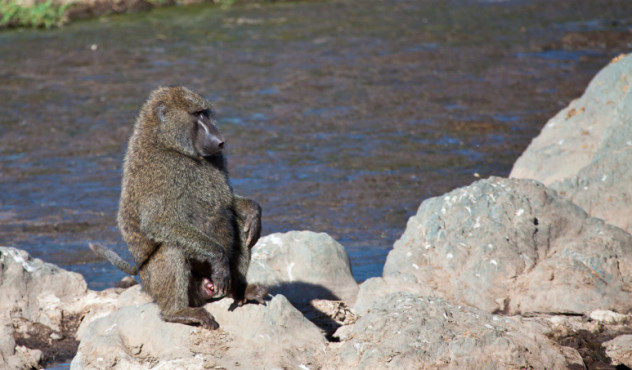
His name is Robinson, and he’s one of the saddest monkeys in all of Africa. Once upon a time, this chacma baboon was on top of the world. He was the king of his troop, the primo primate, the guy you didn’t mess with. In the words of Jim Croce, all the ladies called him “treetop lover,” and the men just called him “sir.”
Then, eight years ago, everything changed. It was just another day in Zimbabwe’s Mana Pools National Park, and Robinson was busy lording it over the other monkeys, when he suddenly found himself stranded. Nobody knows exactly what happened, but Robinson somehow ended up on a small island in the middle of the Zambezi River (thus his name). Perhaps he’d walked across during the dry season and now found himself trapped, or perhaps he swam across to escape a hungry cat. Either way, he’s stuck there, and he can’t get back.
So why hasn’t someone mounted a rescue mission? Well, Zimbabwe’s Parks and Wildlife Management Authority decided they aren’t going to help Robinson, arguing that humans shouldn’t stick their noses into Mother Nature’s business. Several tourists have tried to save the poor guy, but each rescue mission has ended in failure. One man even showed up with a boat full of bananas, hoping to lure Robinson onto his tiny ship, but for some reason, the monkey wasn’t interested.
Unfortunately, Robinson’s days are numbered. Either he’s going to run out of food (he survives on a diet of grass, roots, and birds’ eggs), or he’s going to get washed away in a massive flood. You see, just up the river is the Kariba Dam, a man-made structure in danger of collapsing. Its bedrock foundation has wasted away, and sooner or later, the dam will collapse. When that happens, Robinson will have no choice but to take a little swim (as will the 3.5 million humans in the area).
Hopefully, the government will repair the dam in time, and hopefully Robinson will eventually brave the crocodiles and make it back to shore. Until then, he can only stare across the river, watching his troop as they gather near the water every evening and cry for their lost king.
7A Fake Photograph

Leopards and baboons do not get along. One of the deadliest predators on the planet, leopards love nothing more than a nice snack of freshly killed monkey. On the other hand, baboons aren’t exactly defenseless victims who quiver in fear when a big cat shows up. If you get enough angry monkeys together in one place, they can tear a leopard to pieces. In fact, on one occasion, an angry troop actually tried to drag a leopard out of its den. Chances are good they didn’t want to play tag.
Perhaps no one has captured this intense feline-primate rivalry better than the late John Dominis. A photographer for LIFE magazine, Dominis has taken some truly amazing photos. He’s taken pictures of everything from Mickey Mantle tossing his helmet in anger to Richard Nixon attending a ping-pong match in China. His most famous photo is the “Black Power Salute” from the 1968 Olympics.
But another of his best-known photos is a startling image of a hungry leopard attacking an unlucky baboon. The leopard is charging across the desert sands, back arched, head slightly cocked back like a snake ready to strike. The baboon is absolutely terrified, mouth agape, running backward, too scared to take its eyes off its attacker.
As you might assume, the leopard killed the baboon. The “circle of life” is vicious. Only there’s something wrong here. This iconic image isn’t a picture of nature running its course. Instead, it’s a snapshot of what some people will do to find a good photo. As it turns out, the picture was a setup, staged by John Dominis in 1965.
Believe it or not, it was a common practice at the time for photographers to orchestrate nature photos. Hoping to get a good picture, Dominis had a hunter friend load a captured leopard into the back of a truck, and the two set off to find a baboon. During their trip, Dominis encountered several troops, but each time he unleashed the leopard, the monkeys scattered for the trees—until he found that one stupid baboon who decided to stand his ground. He ended up inside a leopard, and Dominis ended up inside LIFE.
So does Dominis feel any regret? Well, not really. According to him, “I felt that my job was to get the pictures.” If that meant setting up a photo, so be it. “Maybe my attitude would be different now,” he once told a LIFE reporter. “But it wasn’t then, and I don’t know what more to say about it. I had to do what I did.”
6Unnatural Love
While we’re on the subject of leopards taking on baboons, let’s take a look at Dereck and Beverly Joubert. For almost 40 years, this amazing couple has worked in South Africa and Botswana, producing over 20 groundbreaking documentaries for National Geographic.
They’ve been charged by an elephant, attacked by a lion, and even experienced a few plane crashes. Despite the risks, they’ve captured some incredible footage that inspired the creators of The Lion King and changed the way scientists think about African wildlife. What’s even more impressive is that the Jouberts live in a tent in Botswana’s Okavango Delta. Now that’s dedication.
The Jouberts have recorded all sorts of crazy moments (like a pride of lions attacking a full-grown elephant), but perhaps the strangest thing they’ve ever caught on film was when a leopard named Legadema went baboon hunting. The big cat found a juicy monkey, promptly killed it, and was about to chow down when something weird happened. The leopard noticed a baby baboon clinging to its mother’s body. Surprised, the leopard dropped the mother’s corpse, picked up the day-old infant in its teeth, and carried it up a tree.
Only Legadema wasn’t planning on eating the baby. Instead, it was protecting the young monkey, keeping it safe from the hyenas below. As the night went on, the leopard even seemed to be trying to warm the baboon with its own body. Occasionally, the infant tumbled to the ground, and the leopard would hop down from its branch and rescue the baby. This went on for five hours straight, with the Jouberts watching the entire time, until the baboon sadly died from the cold. While it’s sad the monkey passed away, Dereck and Beverly captured a moment when maternal and predatory instincts crashed into one another, and nurture overcame violent nature.
5Corporal Jackie Of The Third South African Infantry Regiment
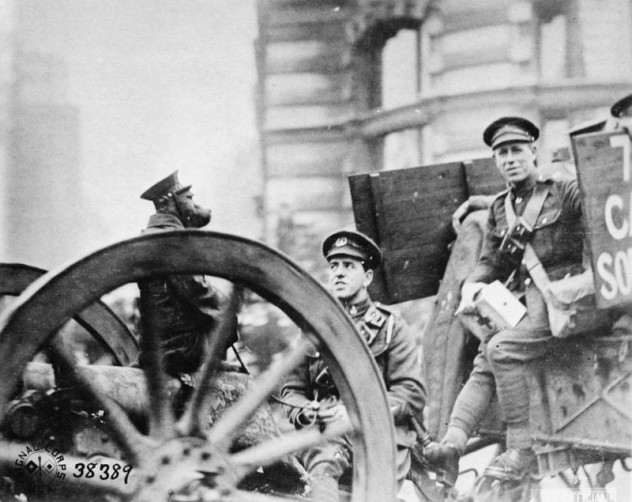
They say the dog is man’s best friend. Well, if we had to choose a runner-up, the No. 2 spot just might go to primates. Of course, whenever we think of friendly monkeys and affable apes, we generally picture chimps, orangutans, or capuchins. It’s a safe bet to say most people wouldn’t consider baboons the primate equivalent of Old Yeller—not in the first half of the movie anyway.
But that’s because most people never met Jackie, the South African baboon. This little guy lived with a farmer named Albert Marr near the capital city of Pretoria. In 1915, Marr joined up with the Third South African Infantry Regiment to do his part in World War I, only he didn’t want to leave his pet at home. When Marr shipped out, he brought Jackie along with him, and the monkey quickly became the regimental mascot. Jackie was given his own uniform, received rations, and was even given his own pay book.
Jackie was pretty much the perfect soldier. He was trained to salute superior officers and learned how to stand at ease. On patrol, Jackie was an excellent watch monkey, and Albert often relied on his buddy’s eyes and ears. And the two saw quite a bit of combat before Germany signed the Treaty of Versailles. During a tour in northwestern Egypt, Marr was injured at the Battle of Agagia, and before the medics showed up, Jackie tried to help by licking Albert’s wound.
In April 1918, Marr was hit again, only this time Jackie was wounded as well. As bullets whizzed by and shells exploded, Jackie tried to build a stone wall for protection. Sadly, a load of shrapnel hit Jackie in the leg, forcing medics to amputate the limb with a pair of scissors while Jackie was unconscious. For his bravery, Jackie was promoted to corporal and was even awarded a medal for valor. Eventually, Albert and Jackie left the front lines and helped the Red Cross entertain wounded soldiers.
Even though they were both wounded, Jackie and Albert made it through World War I alive. They were discharged in 1919, but not before Jackie starred in a victory parade down the streets of London. The two eventually made it back to their farm in South Africa where they both received military pensions. Jackie died in 1921, and Albert eventually passed away in 1973.
4Fred And His Criminal Gang
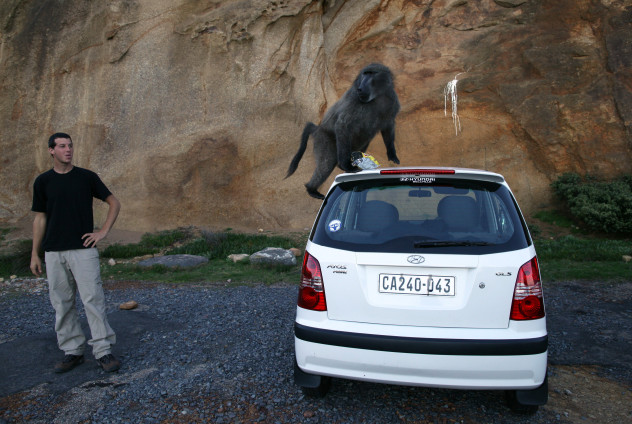
Not all baboons are as friendly as Corporal Jackie. If you look on the other end of the primate spectrum, you’ll find Fred. Fred was actually a chacma baboon, and despite his unassuming name, he’s the Al Capone of the primate world.
Fred and his gang operated out of Cape Town, South Africa, a city home to over 400 baboons. Carjacking was Fred’s specialty, and whenever an unlucky motorist pulled onto Fred’s turf, he went into Grand Theft Auto mode. Fred was known to break into cars with passengers still inside, chase the humans away, and help himself to whatever goodies he found. Fred was such a proficient thief that he could raid four or five cars within five minutes.
Fred was also known to get physical from time to time. He attacked at least three unlucky tourists during his long reign of terror. Needless to say, Fred wasn’t very popular among the Cape Town citizenry. Like any good crook, he had his fair share of enemies and was shot at over 50 times, but no bullet forged by man could stop this merciless monkey.
Unfortunately, you can only fight the law for so long. Eventually, Fred was captured, and the government was forced to make a hard decision. What should they do with him? Unfortunately, Fred was violent and completely unafraid of people. Thanks to tourists feeding the baboons, the monkey saw people as potential marks, and releasing Fred into the wild was not an option. Sadly, the city government decided to put Fred down, and in 2011, the legendary outlaw was put to death via lethal injection.
3A Mock Mummy And A Ghastly God
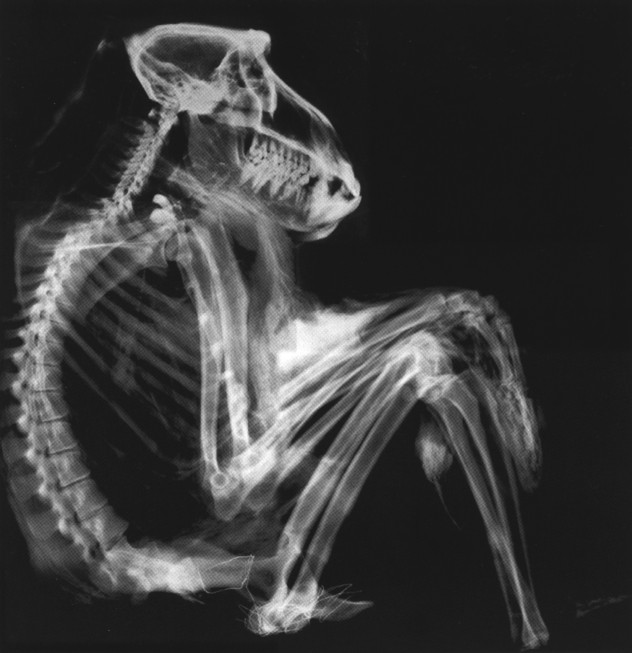
The Rosicrucian Egyptian Museum in San Jose, California boasts one of the largest collections of mummies and Egyptian artifacts in the world. Of course, not all of their bandaged bodies are human. The museum owns quite a few mummified animals as well, and in 2002, they decided to X-ray the preserved corpse of a baboon. Only when they started to X-ray the remains, they noticed something was missing—the skeleton that would normally be seen (as in the photo above).
Upon closer examination, researchers discovered this was no baboon. Someone had wrapped a ceramic vase with bandages, stuck on some fake arms and legs, and put a monkey head on top. Understandably, the director wasn’t incredibly happy about spending so much money on a fake, but it wasn’t like the researchers could call the police. After all, the hoax was thousands of years old.
As we’ve read before, baboons were important animals in ancient Egypt. During the Predynastic Period, Egyptians worshiped a rather aggressive god named Babi. He was basically the alpha male of alpha males. He helped folks get it on in the afterlife, and his rather monstrous member was the bolt on the door of heaven. Babi controlled the darkness, and his favorite meal was a heaping pile of steaming hot human entrails. And you really didn’t want this guy around when you were trying to get into the afterlife, as he had a nasty habit of devouring souls.
As time went on, baboons were eventually linked to Thoth, the god of wisdom, science, writing, and measurement. And that was bad news for baboons. Egyptians were really big on mummifying animals and not just their precious pets. Creatures from birds to bulls were sacrificed and wrapped up like Boris Karloff. Animals could serve as sacrifices to the gods, or they might be used to symbolize a particular deity—such as the (sometimes) baboon-headed Thoth.
In fact, baboons were such popular candidates for mummyhood that their population numbers plummeted. It got so bad that temples actually started breeding programs to keep the baboon business going. Unfortunately, Egyptian baboons eventually went extinct thanks to this odd ritual, and that’s where our fake mummy comes in. Wanting to keep Thoth happy, priests started making artificial baboon mummies which is how, thousands of years later, that ceramic vase ended up in the Rosicrucian Museum.
2Baboon Surgery

In London in 1975, a 13-month-old boy named Scott Molloy was in grave danger. He was unconscious on the operating table as doctors tried to fix a congenital heart defect, but suddenly his kidneys gave out. The surgeons quickly put Scott on a heart-lung machine, but the device wasn’t working.
Desperate, the doctors came up with a radical idea. They decided to surgically connect Scott to the body of a five-year-old baboon. If all went according to plan, the monkey would work as a living life support system, keeping Scott’s heart and kidneys from shutting down. Sure, it sounds like something Dr. Moreau might dream up, but the baboon body can actually accept human blood, and their organs aren’t too different from our own.
After a six-hour surgery, the doctors successfully linked the boy and the baboon, and believe it or not, the plan worked—for a little while. The monkey kept Scott alive for 16 hours, but eventually, the primate couldn’t handle the toxins in Scott’s blood. The baboon passed away, and sadly, Scott followed shortly after.
It’s a depressing ending to a sad tale, but this wasn’t the only time doctors used a baboon in surgery. In 1984, an American newborn named Stephanie Fae Beauclair was found to have a heart defect known as hypoplastic left heart syndrome. Unfortunately, the defect was fatal, so doctors decided to give baby Fae the heart of a seven-month-old baboon. The idea was to use the heart as a placeholder until they could get a human one, but baby Fae passed away over two weeks later, probably due to a difference in blood types. Fortunately, her last few weeks were peaceful, and she could breathe and function like a normal baby until she passed away.
However, not all baboon-human surgeries end in tragedy. In 1992, a man suffering from liver failure was given a monkey liver to keep his system going. Amazingly, the transplant worked, and the liver even grew to normal human size. Before the operation, the man had been lost in a coma, but after the procedure, he was awake and eventually could walk around the hospital. Sadly, he passed away 70 days later from an unrelated brain hemorrhage, but the baboon liver gave him a few extra months with his friends and family.
1The Monkey Mutiny

Monkeys are known across the world for their mischievous nature, and baboons are no exception to the rule. Last year, a baboon by the name of Mickey decided to grope a Fox News reporter, and in 2011, a baboon escaped from a New Jersey amusement park and successfully avoided his captors for three whole days.
But if you want a really outlandish tale of impish monkey business, you need to go all the way back to 1908 when one devilish baboon instigated the furriest mutiny of all time. According to The Daily News, a Western Australian newspaper, a British steamer ship was on its way from India to Philadelphia with a cargo full of 400 monkeys. It doesn’t mention their particular species, but it does note the presence of a rather devilish baboon.
This little rascal was some poor sailor’s pet, and evidently, he felt sorry for all those monkeys caged up below deck. Wanting to free his primate brothers, the baboon slipped down into the cargo hold and opened up the cages. With the door wide open, all 400 monkeys stormed the deck and took control of the ship. Like any good mutineers, the monkeys knew they needed weapons so they stole the ship’s belaying pins, scrambled up the rigging, and hurled the pins at any sailor who stuck his head outside his cabin.
The monkeys had control of the ship for two whole days, leaping from mast to mast, and tormenting the crew. But eventually, the captain came up with a rather brilliant idea. He grabbed several pans, filled them full of molasses, and then spiked the syrup with alcohol. The pans were then set out on deck, and the monkeys just couldn’t resist that sweet sugar.
Hours later, the deck was covered in 400 drunken monkeys, staggering about, and sleeping it off. The little guys were rounded up and put back in their cages, but unfortunately, the article doesn’t mention what became of the baboon. Hopefully he wasn’t strung up from the mast for mutiny.
Nolan Moore has one last thing to say about baboons—SHAKMA! If you want to keep up with Nolan’s writing, you can friend/follow him on Facebook. You can also email him here.








